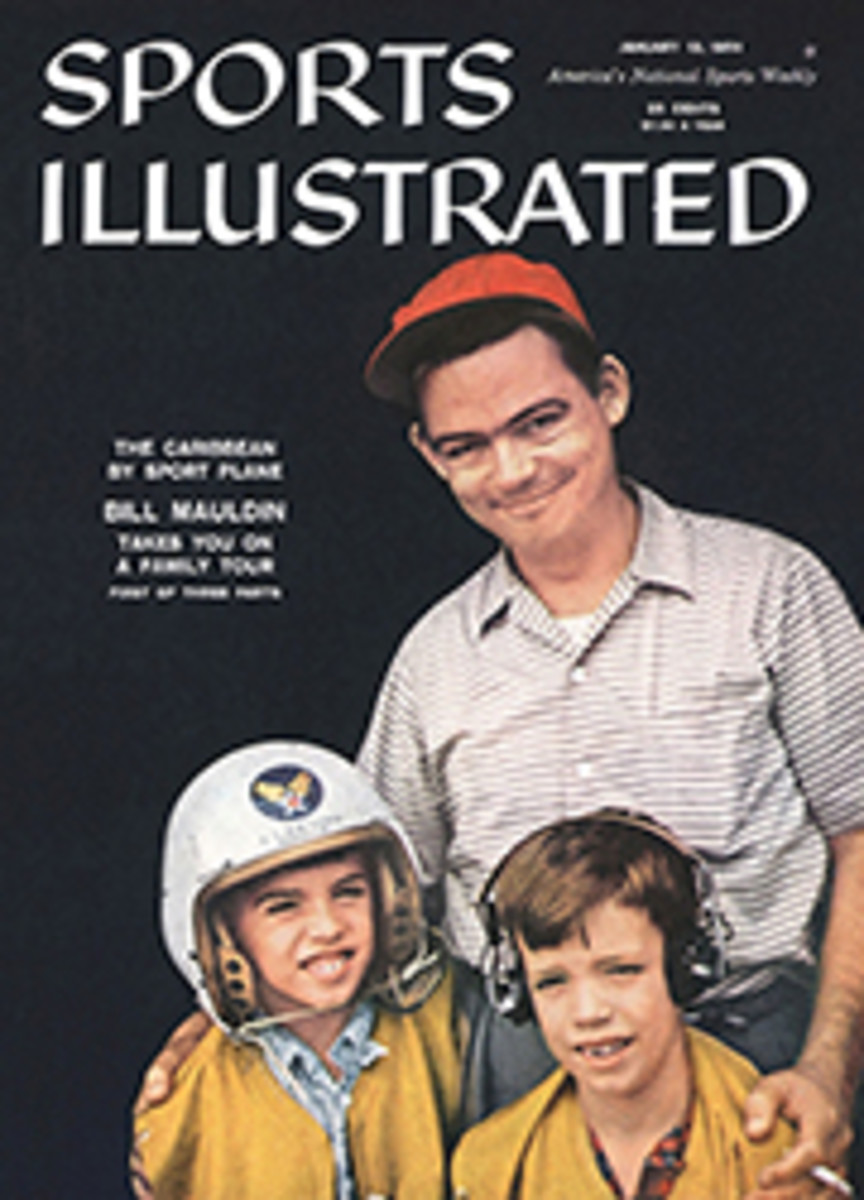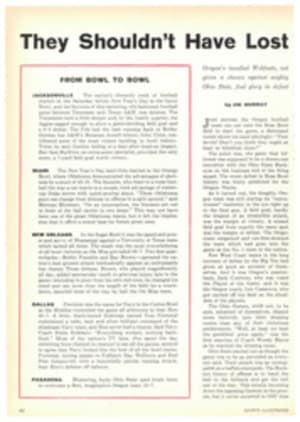
SOPHISTICATION AND SNOW
Aspen is the City of Lights for American skiers. There are resorts that have steeper slopes, and there are others with deeper powder or more exclusive clientele; but none can match the variety of the skiing or the rousing night life of the little Rocky Mountain town 217 miles west of Denver.
Aspen draws the country's sophisticated skiers by the lodgeful. They come, like the skiers in the picture above, to enjoy the superb Alpine atmosphere, to ski the miles of trails and to join the round of after-ski dinners and parties for which Aspen is famous. They come by plane from New York and San Francisco, by car from Texas and Michigan, and by rail from Denver on the California Zephyr winding over and under the Rockies to the nearby town of Glenwood Springs.
When they arrive in Aspen, they see a bustling boom town. But Aspen has not always been this way, nor has it been this way long. In fact, 12 years ago it was a half-deserted mining village. Aspen boomed in the 1880s as a silver-mine metropolis, complete with a $90,000 opera house and a mile-long race track. When the price of silver dropped in 1893, Aspen went bust and stayed busted for 50 years.
Then, in 1945, Walter Paepcke, then president of the Container Corporation of America, arrived in town to buy land for a permanent summer cultural festival he hoped to establish. Paepcke found two things in Aspen: real estate lots selling for as little as $85 apiece, and an ex-Army mountain troop ski instructor named Friedl Pfeifer, who thought Aspen could be the greatest ski town in the U.S.
Paepcke listened to Pfeifer and set out to raise money for a lift. Out of this collaboration came the Aspen of 1958: five soaring ski lifts, half a mountain cleared of trees for skiing, some 40 ski lodges, and a real estate bonanza that has ordinary lots selling for $4,000 to $5,000. The president of the Container Corporation of America is now known here as "Mr. Paepcke that made everything possible."
The focus of Aspen skiing is the wonderful snow bowl at the start of the Dipsy Doodle trail. This is the favorite habitat of the mass of intermediate skiers. The bowl serves also as warmup territory for advanced skiers on their way to running the fine powder slopes on either side of Bell Mountain, the steep pitches of the two-mile Silver Queen trail, or the really tough moguls (lay translation: snow mounds) down Ruthie's Run.
Below the Dipsy Doodle is a huge gorge known as Spar Gulch. Spar's friendly, smooth floor, some 30 yards wide, provides an exhilarating funnel down to the top of Little Nell, a beginner's slope with its own double chair and special set of beginner's moguls.
A word should be said here about the moguls, Aspen variety. They are not to be confused with the eastern kind, which usually grow in well-separated groups of twos and threes. Aspen's are bunched like waves in a choppy sea. The efficient ski school run by Co-Directors Friedl Pfeifer and Fred Iselin teaches skiers how to handle them in controlled runs, but moguls can be murder at high speed.
Unacclimated skiers have discovered that storming down Aspen trails leaves them with just enough strength to crawl into bed by the end of the day, an unfortunate result because the after-skiing night life is too good to miss.
The easiest way for skiers to start the evening is to make the final Christy of the day at the door of the Skiers' Chalet at the base of No. 1 lift and go on in for a beer. Or they can pull up at Little Nell Cafe and get a bourbon toddy and a delicious bowl of oyster stew. This strictly American fare gives way to the European influence at Guido's Swiss Inn, a little farther into town. Guido offers Glühwein, a hot spiced wine pick-me-up best topped off with some of Guido's Swiss pastry.
Hotel Jerome has the biggest bar in town. Consequently, it is considered headquarters for a large portion of the beer-drinking after-skiing crowd. The mirror-backed bar is flanked by old theatrical posters and Gay Nineties barbershop advertising that lists haircuts at 35¢, shaving a corpse at $5.
The alternate headquarters is Beer Gulch, the bar at the Red Onion. The Gulch has preserved intact the fine woodwork of the original miners' bar. More important, it usually has a roaring before-dinner beer sing.
When it comes to sitting down for dinner, Aspen has the best restaurants of any U.S. ski resort. In fact, out of respect for the quality of the public kitchens, Aspen lodges serve only breakfast, if that.
Easily the most exotic menu in the area is the one at the Four Seasons, three miles out of town. There the Copper Kettle kitchen serves—depending on the day—eastern European, Scandinavian, French or Italian cuisine in a candlelit dining hall decorated with early American copper and Oriental furnishings.
In Aspen itself the Red Onion, run by Swiss Chefs Werner Kuster and Arnold Senn, puts out the best charcoal steaks in Colorado. Dinner music is by oldtime Jazz Clarinetist Freddie Fisher, who goes almost back to mining days, plays early, early Dixieland. At Mario's skiers eat Italian and, before or after, perch on stools around the grand piano listening to Mario's fine opera-trained tenor. The town's newest eating place, Le Rendezvous, has a prime rib guaranteed to put iron back in the legs for the remainder of the evening and for tomorrow's skiing. Also new is the Limelite, where Folk Singer Marrilyn Childs holds forth. At the Golden Horn dining room the Saturday special is roast duck. At the club downstairs Steve Knowlton, former U.S. national ski team member, has a between-dance show that is rough, ready and funny. (Steve is credited with the line, "I want you to meet Mr. Possible who made all this Paepcke.")
Getting a room or a bed in Aspen is only a question of price—the town holds 1,500 skiers, so there is plenty of room for everybody. Lodging fees begin at $2.50 for a dormitory bunk at the Roaring Fork and $3 for a bed at the Prince Albert Dormitory. In the medium price range, there are places like Alpine Lodge ($5.50 to $10) and Aspenhof ($3 to $5.50). The Prospector, a top-price lodge, charges $16 to $20. If you arrive in a crowd, the Glory Hole Motel, right at the edge of town nearest the lifts, puts four in a room for $13.
Aspen's high season is February and March, when winter vacations and deep powder snow bring on the crowds. But Aspen is high in the Rockies, so that the snow comes early and stays till late in the spring. From December through April there is, in fact, no really wrong time to come to Aspen, the town that, for skiers, has everything.
Poised for plunge down slalom course, ski racer Max Marolt looks down at Aspen.
Ski instructor Ralph Jackson, a youthful 44, is self-proclaimed "King of the Ski Bums." Bums—the word has no derogatory implication among the ski set—are the skiers who take on available winter jobs at big resorts, asking only that the jobs leave plenty of time for skiing. Jackson taught at Aspen all winter, then disappeared in spring with the snow to tour country by bicycle. Jackson made long cigaret holder and the stocking cap his trademarks while at Aspen.
Visitor Sally Kingman of Concord, Mass. took time off from New York City job to watch national ski championships and world championship team trials held at Aspen last February and March. Together with 1,500 other skiers who jammed lodges to full capacity, Sally saw triple gold medal Olympic Champion Toni Sailer beat some of world's best in typically exciting Aspen races. Afterward she sampled trails on her own, found them as much fun for recreation as for races.
Waitress Dianne Merrill of Portland, Ore. is typical of pretty ex-collegians who spend winter in Aspen. Regular job waiting on tables at Golden Horn restaurant gave Dianne free time to ski all morning, enjoy parties with Aspen's younger crowd after work. Girl members of Aspen ski-bum set are less serious than men, usually try the life for a year or two, then retire into marriage. Many return later as visitors, bringing their husbands and children for winter vacations.
Steep snow fields of Silver Queen (above), Aspen's toughest ski trail, fall away before spectators while far below racers schuss the sharp-breaking slopes typical of this rugged ski terrain. At the end of Aspen trails, bright-clad skiers (below) fraternize leisurely while waiting their turns at chair lift for ride back up.
Impromptu gaiety of an accordion session on the sun porch of Skiers' Chalet brings happy grins to Olympic Skier Skeeter Werner and Musician Eric Lundberg. Varied bars, restaurants and night clubs make Aspen's social life busiest of all U.S. ski resorts.
PHOTO
TONI FRISSELL
LUNCHING ON SUNDECK AT TOP OF ASPEN, FRANCOIS DE GUNZBURG AND MRS. I. E. PETERSON ENJOY MAGNIFICENT ALPINE SCENERY
MAP
ASPEN TRAILS: 1: Sundeck; 2: Buckhorn; 3: Silver Bell; 4: One and Two Leaf; 5: Copper trail start; 6: Copper; 7: Gentleman's Ridge; 8: Collins Gulch to Grand Junction; 9: Bell Mt. Ridge; 10: Spar Gulch; 11: Short Snort; 12: FIS trail; 13: FIS start; 14: Little Corkscrew; 15: Roch; 16 and 21: Silver Queen; 17: Magnifico Cutoff; 18: Corkscrew; 19: The Island; 20: Mine Road; 22: Little Nell; 23: jump; 24: Hoagland; 25: Norway Slope. ASPEN LIFTS—A: No. 1; B: No. 2; C: No. 3; D: No. 4; E: No. 5.
SEVEN PHOTOS
TONI FRISSELL

